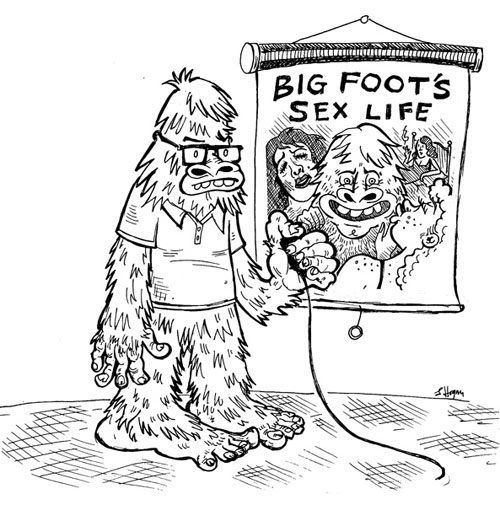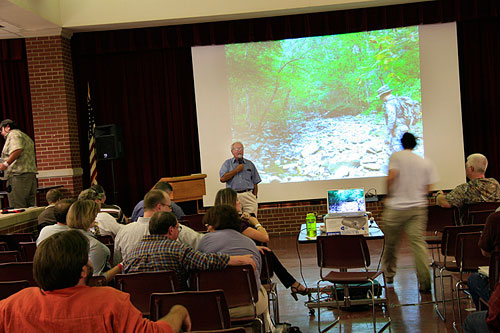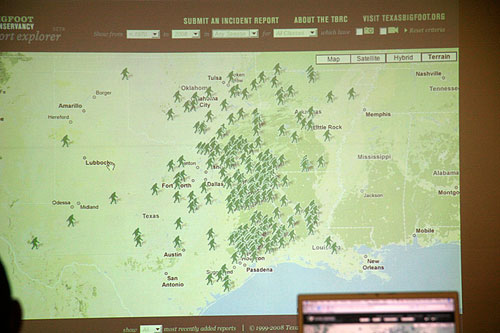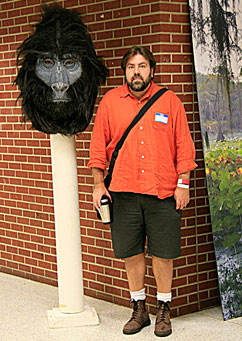Bigfoot Encounters
Monsters: " Everything's Bigfoot in Texas"
by Eric Spitznagel

October 30, 2008 -- In a high school cafetorium, a small man in his mid-70s was lecturing to a rapt audience of several hundred people. Dr. Henner Fahrenbach, a retired zoologist from Oregon, is also a self-proclaimed expert in the behavioral habits of a bipedal ape sometimes known as Sasquatch.
“Their top speed for running is between 42 and 45 miles per hour,” Fahrenbach told the crowd, in a thick German accent. “They can cover 90 feet in just three steps, or 30 feet per step. So obviously, they have immensely powerful thighs and legs in general.”
Fahrenbach, one of the featured speakers at the seventh annual Texas Bigfoot Conference, held on October 18 in the north-eastern Texas town of Jefferson, seemed an odd choice for an event that promised to “establish the legitimacy” of the field. Unlike his colleagues—an assortment of authors, academics, and independent Bigfoot researchers—Fahrenbach made no secret of his beliefs. He didn’t speculate about the “possibility” of Bigfoot’s existence. He’s convinced that Sasquatch is not only real but borderline supernatural—a monster straight out of Greek mythology.
“Sasquatch has been observed walking with two 200-pound pigs under his arm through the countryside,” Fahrenbach declared. “On another occasion, he’s been witnessed grabbing three goats with one arm and walking over a five-foot fence without breaking stride.”
(Photo shows Fahrenbach during presentation...)
Drawing on interviews with dozens of eye-witnesses, Fahrenbach went on to say that Bigfoot’s diet is rich in mussels, clams, peacocks, and the “hindquarter” of deer. He insisted that Bigfoots enjoy wrestling, tickle fights, and, most surprisingly, gangbangs. He assured us that even a horny Sasquatch has an impeccable sense of orgy etiquette.
“When an especially large male came onto the scene,” Fahrenbach said, describing a sexual pileup involving one willing female and lots of dudes, “he didn’t try to buck the line but simply stood there and took his turn in good time.”
In the beginning of his lecture, there was some nervous giggling from those in the audience. After a while, they just stared at Fahrenbach, a few with jaws agape. Somewhere in the back row, a woman turned to her husband and whispered, “I can’t tell if he’s kidding.”
It’s been a rough few months for Bigfoot true believers. Last August, a pair of hoaxers in Georgia tried to convince the world that they’d found a Sasquatch carcass, which turned out to be a cooler filled with animal entrails and a rubber gorilla costume. The Bigfoot legend has always been a hard sell, but after such a high-profile scandal, it hasn’t been easy to keep the faith when even casual cryptozoologists are portrayed as gullible or insane, and sometimes both.
At least during the first half of this year’s conference, the speakers tried to prove that all Bigfoot researchers aren’t con artists or rednecks who subscribe to the Weekly World News. Most of the morning was devoted to raw data, delivered in a grave monotone by Daryl Colyer, a member of the Texas Bigfoot Research Conservancy. He rarely used the word Bigfoot, opting instead for vague descriptions like “unlisted primate species” or “unknown, upright hair-covered species.”
 Colyer numerated a staggering amount of minutiae from reported Bigfoot sightings, including the creature’s hair color (31 percent of witnesses claim it’s red-brown), location of sightings (2 percent of Bigfoots hide up in trees), what the witness was doing during sightings (11 percent were fishing, 5 percent were biking, and just 2 percent were in the midst of a picnic), and a vast array of Bigfoot’s vocal sounds, from growls and screams to whoops, grunts, roars, howls, moans, and hoots. “A hoot could be interpreted as being the same thing as a whoop,” Colyer admitted without cracking a smile. (Photo caption is Texas sightings map)
Colyer numerated a staggering amount of minutiae from reported Bigfoot sightings, including the creature’s hair color (31 percent of witnesses claim it’s red-brown), location of sightings (2 percent of Bigfoots hide up in trees), what the witness was doing during sightings (11 percent were fishing, 5 percent were biking, and just 2 percent were in the midst of a picnic), and a vast array of Bigfoot’s vocal sounds, from growls and screams to whoops, grunts, roars, howls, moans, and hoots. “A hoot could be interpreted as being the same thing as a whoop,” Colyer admitted without cracking a smile. (Photo caption is Texas sightings map)
Later, a wildlife biologist from Oklahoma named Alton Higgins talked about Bigfoot hoaxes, using a PowerPoint presentation to demonstrate how costumes and obvious frauds could be identified. There were the obvious clues—thick, tubular lower legs and zippers—and also more complicated hoax telltales, like irregular arm-leg symmetry and head/humerus proportions.
The audience nodded appreciatively, and those clutching notebooks wrote down every detail, as if these observations directly affected their own research. They were primarily male and middle-aged, an even mix of grizzled hunters and fantasy fan-boys. It was a sea of grey beards, plaid jackets, and Bigfoot-kitsch t-shirts.
But just how serious are they? According to Brian Brown, the conference’s M.C. and the host of several Bigfoot podcasts, their interest level is somewhere between aloof skepticism and giddy enthusiasm.
“A lot of people here try to be as conservative as possible,” he said. “It’s all about the results and not jumping to conclusions. But as in any field of study, there are a large number who just want to believe. They want to go out into the woods and get scared. They love the idea that there’s a hairy monster out in the shadows somewhere.”
Michael Cathey, a Bigfoot enthusiast from Oklahoma (he runs his own canoeing business called Bigfoot Floats), falls into the latter category. “I remember doing reports on Bigfoot in Junior High,” he said. “That’s what I wanted to do someday, go out and find Bigfoot. But you know, the older I get, I kinda don’t want him to be found anymore. It’s better as a mystery.”
Those who’ve devoted their careers to studying Bigfoot, however, aren’t content to let it remain folklore. And they certainly don’t like being dismissed by a cynical media. David Paulides, a conference speaker and Bigfoot researcher from Northern California, complained that “the biggest headlines are for the hoaxes and the people who probably aren’t doing the best kind of research. The guys in the background, who are sitting in the woods and doing the hard work, they aren’t getting the press they deserve.
“Like Dr. Meldrum,” he continued, pointing to a man sitting behind a table and selling plaster cast Bigfoot footprints for $40 a pop. “He put his entire career on the line by coming out and saying, ‘Hey, these things are real.’ And he’s still ridiculed about it. There’s a hero for you to write about.”
He may have a point that the media can be too quick to judge, but he and his peers need to share at least some of the blame. It was impossible not to smile during the conference when a lecturer was introduced as “the foremost expert and collector of Sasquatch hair,” or when a speaker discussed Bigfoot’s criminal history (according to Native American legend) of kidnapping young boys and eating human flesh, or when Paulides made the disturbing revelation that Bigfoot might be drawn to menstruating women, and has been observed digging though garbage cans, looking for used tampons.
If they don’t want to be ridiculed by the media, then they should try a little harder not to make it so easy.
They haven’t exactly received a warm reception from mainstream science, either. “Obviously there is no official consensus when it comes to a controversial topic,” said Dr. Jeff Meldrum, an associate professor of anthropology at Idaho State University, where many of his fellow professors have publicly dismissed his Bigfoot research as a “joke.” “Such a thing is a rarity in the scientific community, especially one such as the possible existence of Sasquatch. Those most vocal are the ideological or professional skeptics. But I find more and more colleagues interested to learn more about what I am doing to investigate this question.”
Dr. Henry Gee, a senior editor for Nature magazine, doesn’t think the climate is quite so accepting. “In my opinion, the scientific community at large regards Bigfoot as either a figment of peoples’ imagination or a hoax,” he said. Which doesn’t mean he doesn’t subscribe to his own special brand of crazy. “That’s not to deny the possibility, even if remote, that unknown human-like creatures might await discovery in some part of the world,” he said. “The discovery of fossils of Homo floresiensis, otherwise known as “The Hobbit,” a strange humanoid creature that lived in Indonesia until at least 14,000 years ago, increases that possibility.”
In other words, Sasquatch is probably fictional. But Hobbits running around in a prehistoric Middle Earth? Totally real!
 “Some day a good picture’s going to come out,” said Robert Swain, author of an unsyndicated comic strip called “Laughsquatch,” in one of the most heartfelt speeches of the day. “And it’s not going to be the Georgia hoax that we’ve all cringed about. It’s going to be something that you can really put stock in, and people are going to start looking at this community as something that’s really credible and something they need to take seriously. We probably have an endangered species that’s a very important scientific find, right here under our noses. We need to help science because science doesn’t know what to look for. It’s going to be up to us to find it.
“Some day a good picture’s going to come out,” said Robert Swain, author of an unsyndicated comic strip called “Laughsquatch,” in one of the most heartfelt speeches of the day. “And it’s not going to be the Georgia hoax that we’ve all cringed about. It’s going to be something that you can really put stock in, and people are going to start looking at this community as something that’s really credible and something they need to take seriously. We probably have an endangered species that’s a very important scientific find, right here under our noses. We need to help science because science doesn’t know what to look for. It’s going to be up to us to find it.
“I appreciate everybody that’s out there looking for Bigfoot,” he added. “Because I think it’s only a matter of time before we bring him home.” (Photo is author of article posing with a Bigfoot's head...)
Perhaps the most telling moment of the conference occurred during the panel discussion. Asked if they thought it was ethical to shoot and kill a Bigfoot—if only to collect DNA samples for research—every speaker, without hesitation, said no.
“It doesn’t have to be killed,” said Craig Woolheater, the conference’s director and founder. “Somebody could be hiking in the woods of north Georgia, for instance, and actually find a Sasquatch body. But until that happens, we’ll stick with documenting it with video and photographic evidence.”
Kathy Strain, the author of a collection of Bigfoot lore called Giants, Cannibals & Monsters, just shrugged and said, “I don’t know that DNA is necessarily going to make or break this case.”
It’s unlikely that Bigfoot research will ever gain the credibility its proponents crave, at least while they consider DNA overrated. Real science requires more than blurry photos and first-person accounts from jittery hikers. But maybe scientific legitimacy isn’t as important to them as they claim. After all, gathering too much information might backfire, accidentally disproving the creature they’ve come to love and need. Better to keep Bigfoot at a safe distance, where it can remain mythical and larger than life, leaping over canyons and kidnapping women and hosting forest gangbangs.
The last word on Bigfoot hunting went to Dr. Fahrenbach. The question of whether to shoot Sasquatch was moot, he said, because such a plot would never succeed. “Bigfoot would just swat at the bullets as if a bee had stung him.” The audience laughed, but it wasn’t a derisive laugh. It almost sounded like a sigh of relief.
The mystery of Bigfoot, at least for now, is safe.
Illustration by John Hogan
Photos by Jim Lichtenwalter
http://www.vanityfair.com/
COMMENTS:
Back to Bigfoot Encounters Main page
Back to Newspaper & Magazine Articles
Back to Bigfoot Encounters "What's New" page
Portions of this website are reprinted and sometimes edited to fit the standards of this website
under the Fair Use Doctrine of International Copyright Law
as educational material without benefit of financial gain.
http://www4.law.cornell.edu/uscode/17/107.html
This proviso is applicable throughout the entire Bigfoot Encounters Website.
This is the best Bigfoot article I've read this month. Seriously, Spitznagel manages to combine satire and true affection in this hilarious piece. Well done.
Posted 10/30/2008 by kleonardSpitznagel nails it. This sad, suffering, respect-craving lot of folks are second only to "Furries" on the lower rungs of geek culture. It's hard to take something this silly seriously, but it sure is fun! Congrats to Vanity Fair for having the nuts to run something like this! Outstanding!
Posted 10/30/2008 by LunchmonkeyWith the whole world increasingly mapped out and demystified, Big Foot still offers people a little mystery and magic. I hope he does exist and that no one ever finds him. And with these folks "researching" him, I don't think we'll find him any time soon. Great story!
Posted 10/30/2008 by animilyI feel quite touched by that. These people, though I think they are beeing rather foolish, keep alive the sparkle of magic and fantasy that makes us truly human. And the story is very well written.
Posted 10/30/2008 by GlosterI never thought I'd identify with bigfoot hunters. The author makes them somehow sympathetic...but still lets me laugh. Well-written.
Posted 10/30/2008 by sittingbertBravo, Bravo, Bravo. Where have you been hiding this guy. Enjoyed the satire. Look forward to future articles from Mr. Spitznagel. Long live the legend of Bigfoot. SLGKREGS
Posted 10/31/2008 by slgkregsEric, What a great piece. I can only imagine what an ole' fashion Bigfoot gangbang looks like. I am glad all BFs involved are repectful of the other BFs while in a giant orge. Great article. Have a good Halloween. Don't frighten the children. Lou
Posted 10/31/2008 by Lou1981What a great article. Intelligent, funny, and a window into a strange little world. I managed to laugh while sympathizing with these people at the same time.
Posted 10/31/2008 by phinThis is great. It's so funny and poignant. Brilliant writing. Thanks for the entertainment.
Posted 11/2/2008 by mshoustonI cannot wait to grab up my lady friends and finally catch Big Foot. Surely the scent of our monthly flow will bring him out of hiding. Awesome piece.
Posted 11/3/2008 by msclamsticks